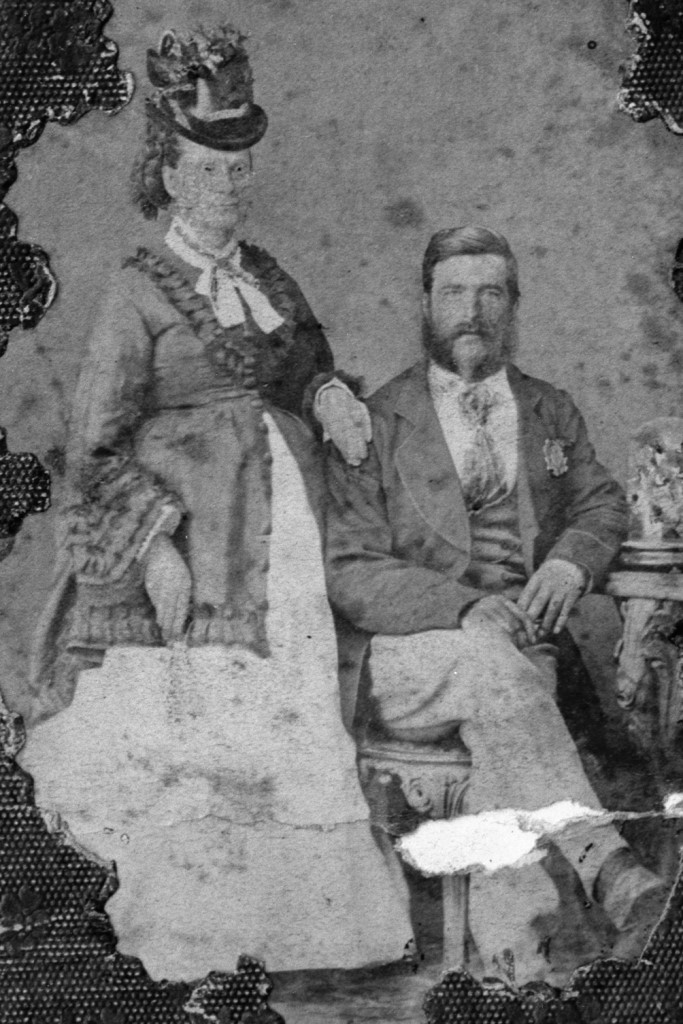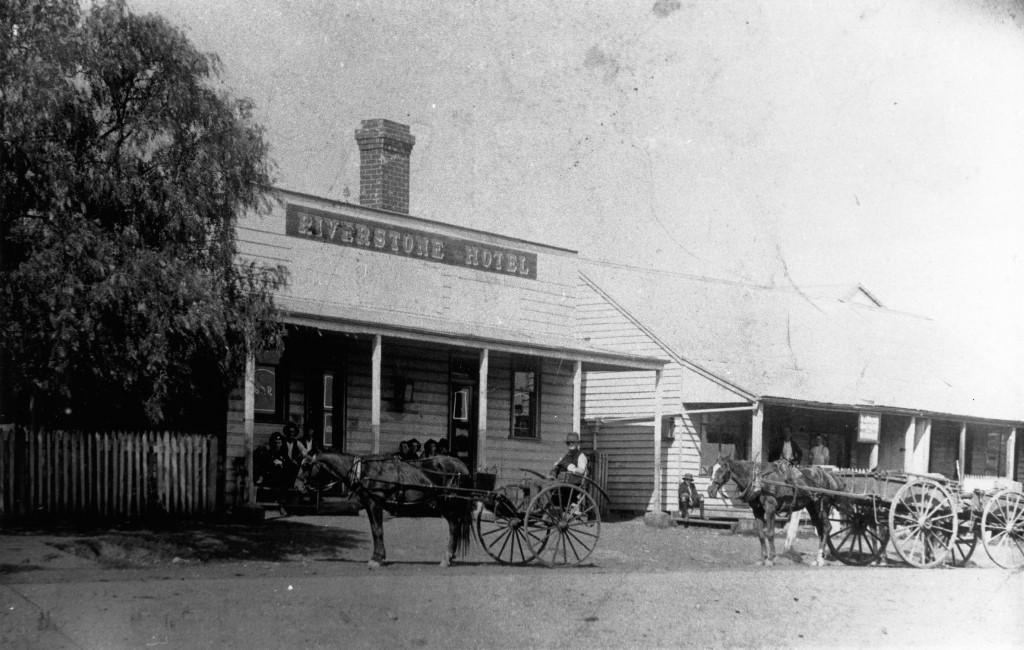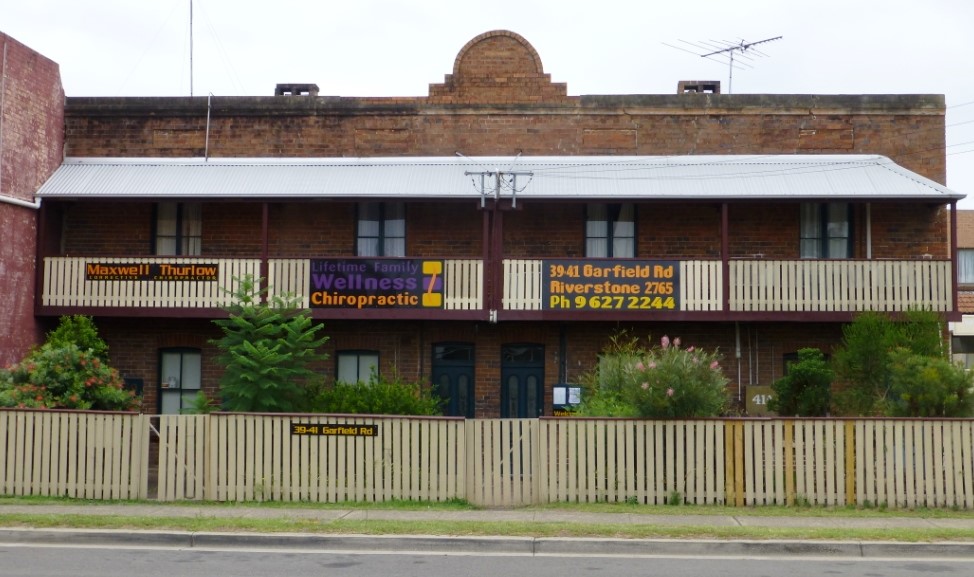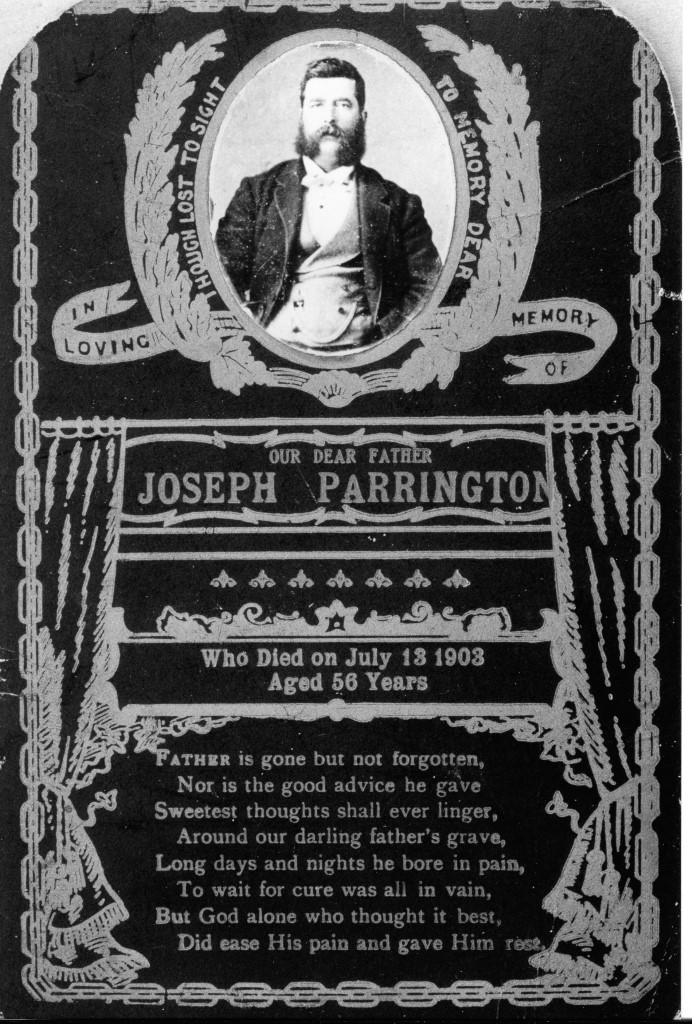by Judith Lewis

Reading about Riverstone in the local papers of the latter part of the 19th century you come across the name of Joseph Parrington on many occasions, yet little is known of his early life.
We have no record of when or where he was born but we do know that he married Johanna Barry in 1873 in the district of Newtown. Joseph and Johanna are shown in the photo to the left.
They had two children, Ann (b. 1875) and Henry (b. 1877). Their births were both registered in Sydney.
Joseph’s first connection with Riverstone shows him, from 1879 to 1882, as the builder, owner and licensee for the first hotel in the town, the Riverstone Hotel.
On 21st August 1879 Joseph Parrington is described as a publican and butcher (the butcher’s shop was adjacent to the hotel).
The hotel stood diagonally opposite the railway station. It was demolished in 1915 and in 1925, Conway’s Newsagency was built there. A hairdressing salon now occupies the newsagency building.

It was also on 21st August 1879 that a local committee, comprising Joseph, Thomas Cuneen and John Schofield, representing the residents of Riverstone, applied to the Council of Education for the establishment of a Public School. The school was promised but it wasn’t till Joseph and John Schofield Jnr. wrote, on 19th August 1881, to the Minister of Education, that a site was settled on. Plans were completed, accepted in March 1882 and the school was finally opened in January 1883.
An article in the Australian, Windsor, Richmond and Hawkesbury Advertiser on Saturday 5th March, 1881 was headed Sunday Selling and stated, “Joseph Parrington, keeper of a public house at Riverstone, was charged with selling liquor during prohibited hours to one Edward Parsons, on Sunday, 13th February last. Defendant pleaded not guilty. Michael Murphy gave evidence as to giving Parsons money, and asking him to go into defendant’s public house, and when he came out he smelt of drink. Edward John Parsons said he was served with drink (beer and syrup), for which he paid 3d. (three pence); he went to school, but never learned the clock, and cannot tell it. Mr. Dargin said he was not prepared to fine defendant on Parson’s evidence. The majority of the Bench fined defendant 20s (shillings), and 7s 8d costs.”
Later that year Joseph Parrington was advertising for men to split wood and that he could supply in any quantity Ironbark posts and rails, Stringy and Ironbark saplings and Stocks. The timber could be seen at Riverstone Railway Station and application had to be made to himself, hotel and storekeeper, Riverstone. As well as running the sawmill, Joseph owned a great number of properties in and around Riverstone, including “a fine orchard on the road to Schofield’s Siding”.
On Wednesday, October 18th 1882 Joseph was before the court again, this time the Metropolitan District Court, where he was claiming, from the Commissioner for Railways, the sum of £30 (30 pounds or $60) for the value of a horse. Both parties were represented by solicitors with Parrington’s solicitor, Mr. Bruce Smith being instructed by Mr. Freehill and the defendant by Mr. Edmonds, instructed by the Crown Solicitor. Smith & Freehill charged that the Railways were negligent in looking after the railway gate, leaving it open so that the plaintiff’s horse was permitted to stray across the said railway so that it was knocked down and killed by the defendant’s train passing over it. The defendant’s evidence was that whilst the horse was found dead on the railway line there was no evidence of its having been killed by a train. They also proved that the animal had been in the habit of trespassing on to the line and that the owner had been warned of this and threatened that it would be impounded. There was also evidence that the horse had been seen to jump the railway line fence. His Honor (sic) gave his verdict to the defendant and costs were awarded to three witnesses.
On 8th December 1882 Joseph advertised that he had sold his business of Publican and Storekeeper to Mr. George Ireland. It sold for £3,500. In October 1883 he advertised in the Sydney Morning Herald (SMH) for bricklayers to tender for the laying of 55,000 bricks. It was in 1883 that his four terraced houses in Garfield Road were completed. They are still standing and, today, are used as commercial premises as show below. Local have always referred to them as “Parrington’s Terrace”.

In June 1884, from his sawmill near the railway station, he advertised in the SMH “to woodcutters and others” the sale of machinery, tools timber etc. “no reasonable offer refused, as the owner has no more use for it”. Other business ventures of Joseph included an orchard opposite the railway line between Riverstone and Schofields
Joseph remained active in community life. At a “large and influential meeting”, in October 1884, to elect a permanent Progress Committee, to “represent the interests of the district…and also co-operate with Windsor and Richmond in their railway agitation” Joseph was elected Treasurer. On 14th March 1885 a paragraph in the Hawkesbury Chronicle and Farmers Advocate makes the following comment “…To our mind, Riverstone is a very accessible place for a man who wants to live upon his own bit of land cheaply, and get out of crowded, expensive Sydney; and we conclude that Mr. Parrington, who made his pile on these “diggings”, and Messrs. West, Wood, Lepherd, Mitchell, Showler, Ireland, and others who are making theirs, think as we do”. Joseph was also an active member of the Grand United Order of Oddfellows Lodge.
Joseph also kept up his involvement with the Riverstone Public School he had worked tirelessly to see established in 1883. In July 1886 he was Chairman of the Committee that had organised a school picnic. The Hawkesbury Chronicle and Farmers Advocate reported that Mr. Joseph Parrington’s “advice was imparted to the children impressing upon them the advantage to be gained by paying attention to their teacher. A vote of thanks was then given to Mr. and Mrs. Langton (the teacher) by acclamation”
On 7th November 1885 Joseph’s Mountain View Estate Riverstone was advertised for private sale. It was an area of 24 acres, close to the railway, with three frontages, a good view over the township of Riverstone and the mountains, divided into nine paddocks, 2 large dams, 13 acres in cultivation, with a large frontage to the railway and including an eight roomed house, verandah on three sides, well elevated. In the 1885 Parliamentary Return of Landholders for Riverstone he is listed as owning 26 acres with 1 horse and 20 pigs. On 21st March 1886 the SMH advertised an auction, on behalf of Mr. Joseph Parrington, of 130 pure Berkshire pigs and about 100 pairs of poultry and other items, including lease of premises. The property was again advertised in March and April 1889. Joseph’s orchard was still in operation in December 1894, as evidenced by this entry in the Windsor and Richmond Gazette (the Gazette) “… Mr. Joseph Parrington’s red may peaches realized the highest price in the Sydney market… Mr. Parrington dispatched 62 gin cases of those peaches in one week.” In March 1895 the SMH stated “SACRIFICE £2000, less than cost price – Grand HOMESTEAD”.
Hard times saw most of Joseph’s Riverstone properties, the Homestead, the Terrace Houses and a 2 acre block having frontages to Railway Parade and Carlton Street put up for auction by Mr. F. Wheeler Auctioneer of Riverstone, on 30th November 1895. A further auction, by Mr. W. Gosper of Windsor was held on 11th April 1896. They must have had some success as the Gazette commented on 2nd May “Referring to the auction sales held here lately, one must come to the conclusion that times are gradually getting better financially. The prices realized at Mr. J. Parrington’s sale astonished some of those who attended.” On 20th June the same paper advised, “Mrs. Grace’s cottage has been let to Mr. Joseph Parrington, who has now given up his orchardist’s occupation, and had taken to dealing”.
In February 1898 Joseph’s fortunes looked like changing with the following paragraph in the Gazette, “it is stated that Mr. J. Parrington, of this town, has a chance of possessing a fortune in the near future. He has received word that he and his brother are entitled to £100,000 bequeathed by a relative. The amount is in Chancery in England.”
No further mention is made of this good fortune and in June 1898 the Gazette relates that Joseph Parrington of Riverstone had applied for and been granted a packhorse licence. It further comments, at an unknown date, “A fair trade is being worked up by Mr. J. Parrington, who has started in the hawking line. He is selling the best goods”. Later we read “A few days ago Mr. J. Parrington, who was on his round near Kenthurst, put his horses in an enclosure for the night, but on his looking for them the next morning found they had disappeared. They reached home early next morning, and they were taken back to where they got loose”.
The Gazette of 15th October 1898 commented “Mr. Joseph Parrington, who has resided in Riverstone for the past 20 years, is about to remove to Seven Hills, where he intends to start business near the Railway station. Mr. Parrington has always been known as a straight goer, and his many friends will be glad to see him succeed in business there”. Two of his good friends, Messrs J and T Shoular placed Joseph’s furniture on the train for him. Joseph’s son, Harry, remained at Riverstone for a time. Again it was the Windsor and Richmond Gazette reporting, “Mr. Joseph Parrington, late of Riverstone, is now the proprietor of a very nice looking store at Seven Hills railway station. His many friends here wish Joe a return of the good fortune which deserted him some good few years ago at Riverstone.” Meanwhile, back in Riverstone, Mr. Frank Wheeler, auctioneer, reported the leasing of Mr. Parrington’s late homestead and orchard to Mr. Frederick Morris, of Glebe Point, Sydney. The Parrington Homestead finally sold in January 1905 to Mr. Hy. Wood, who intended to reside there.
The Parrington’s daughter, Ann, accompanied her parents to Seven Hills. Their son Harry, who had been employed as a slaughterman at the Riverstone Meatworks, left Riverstone at the beginning of 1899 to sail to New Zealand where he was again employed as a slaughterman. There he met Mark Sullivan and other Riverstone “boys”. Harry returned from there in April, accompanying one of the “boys”, Will Hansell. He then resided with his family at Seven Hills.
Good fortune did not find Joseph at Seven Hills. He had, for many years, suffered with acute rheumatism. In his latter years he also developed Bright’s Disease and heart trouble. In 1899 he spent considerable time in Parramatta Hospital and was now practically an invalid. In 1902 Joseph Parrington was declared bankrupt. The bankruptcy sale of his furniture etc. “brought marvellous prices” (for the buyers), good furniture such as beds and chests of drawers being “knocked down at 6d each. In 1902 the Parringtons had “removed into Mr. Cassidy’s house beyond the Eastern Creek”. Ann accompanied her parents and, as Harry, considered a very good footballer, was listed as a player for Riverstone playing against Erskineville in November, it is presumed he did also.
Joseph Parrington died on 11th July 1903. His funeral was “largely attended”, with members of his Lodge, the GUOOF, signifying the esteem with which he was held, by marching in full regalia. He was buried in the Church of England section of the Riverstone General Cemetery. The Riverstone people rallied to the family’s support and a benefit concert and dance in the Oddfellows’ hall was held on Saturday, 14th November. A sum of £5 was raised.

In May 1904 Mrs. Johanna Parrington was to accidentally scald herself very badly and her daughter, Ann, who had been living in Sydney, came home to nurse her mother. Two years later Ann was “quietly married in Sydney, to Mr Alma (Alymer) Mellish, son of Mr Edward Mellish, of Windsor”. Johanna moved to Windsor to live with Annie and Alymer. She was to pass away, in Windsor Hospital at age 75, in October 1909. She had been born in Ireland and was buried in the Roman Catholic Cemetery in Windsor. At the time of her death her son, Harry, was living at Glebe Island.
The Gazette, in October 1916, reported “Private H. Parrington, brother of Mrs. Alymer Mellish, of Windsor, has just had his final leave, and was on a visit to his sister for a few days … He expects to sail for the front shortly”. In April 1918, under a heading “Welcome Home Boys Who Have Done Their Bit”, the Gazette listed Private Harry Parrington as one of those “soldiers who have recently returned from the blood-stained battlefields” being present at a welcome and send-off, held in the Windsor School of Arts and organised by the Win the War League. Harry’s death, at Lidcombe Hospital, is recorded as occurring on August 14th 1930. The only family member mentioned in the SMH funeral notice is his beloved sister, Mrs. Alma (sic) Mellish of Windsor. Harry was 53. One may then assume that Harry had no family which means Joseph’s line of the Parrington family did not have any descendants carrying on the family name.
Ann was to die on 31st January 1937 at Windsor. She was the dearly loved wife of Alymer Mellish and fond mother of Gordon, Vera and Edward and was 61. Both Harry and Ann were buried at Windsor.
These days many Australians are said to be of the ilk that delights in “cutting down tall poppies”. It says much for the character of Joseph Parrington and of the Riverstone townsfolk of his time that, throughout Joseph’s life, the Riverstone townsfolk continued to hold him in high esteem.
